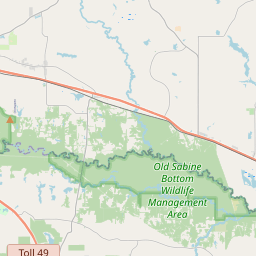Head of Navigation on the Sabine River, Belzora Landing
Historical marker location:






A thriving port for Tyler and East Texas, from 1850s until arrival of railroads in 1870s. One of many ports established when settlers (as in eastern states) turned to rivers for transportation. In Texas, river-freighting proved rather disappointing. The long, winding rivers were difficult for even small, shallow-draft steamers to navigate. Boats on the Sabine fared very well, however, because of abundant rainfall and favorable terrain.
For several months each year, light steamboats could ascend the river to Belzora. The "Galveston News" for that period included Belzora in listings of ports. In dry seasons it was local practice to load goods on barges, flatboats and other craft and wait for a freshet to send them downstream.
In addition to the boat landing, Belzora had a ferry used by travel on the Dallas-to-Shreveport Post Road. The town had a dozen businesses, a post office and a combination church-schoolhouse.
Ambitious plans for greater inland navigation, deepening of river channel, and building of locks and dams never materialized. Belzora, like many sister ports, became an historic relic-- a ghost town
As one of the most visible programs of the Texas Historical Commission (THC), historical markers commemorate diverse topics in Texas history, including: the history and architecture of houses, commercial and public buildings, religious congregations, and military sites; events that changed the course of local and state history; and individuals who have made lasting contributions to the state, community organizations, and businesses.
Texas is also home to the world's largest honky-tonk, Billy Bob's Texas in Fort Worth. The venue covers three acres and can hold up to 6,000 people.
During the turbulent times of the American Civil War, Smith County experienced significant unrest. Many residents in the county owned slaves, and tensions ran high between Union and Confederate sympathizers. The Battle of Blackjack Grove took place in August 1864, and although it was a minor skirmish, it reflected the deep divisions and struggles faced by the county during the war.
Following the war, Smith County experienced rapid growth and development. The arrival of the railroad in the late 19th century further boosted the county's economy and population. During this period, the town of Tyler established itself as a principal commercial center, attracting businesses and settlers from surrounding areas.
In the 20th century, Smith County continued to thrive with the growth of agriculture, oil, and manufacturing industries. Tyler became known as the "Rose Capital of the World" due to its substantial rose-growing industry. The county has also been a center for education, with the establishment of schools and universities.
Today, Smith County remains a vibrant and dynamic part of Texas. Its rich history, from its Native American roots to its role in the Civil War and beyond, provides a fascinating backdrop to its current achievements and endeavors.
Smith County Timeline
This timeline provides a condensed summary of the historical journey of Smith County, Texas.
- 1846 - Smith County is established by the Texas legislature.
- 1847 - The county seat is designated at Tyler.
- 1850 - The population of Smith County reaches 1,726.
- 1861-1865 - The Civil War impacts the county, with many residents serving in the Confederate Army.
- 1877 - The Texas and Pacific Railway reaches Tyler, boosting the local economy.
- 1930s - The Great Depression brings economic hardships to Smith County.
- 1932 - The East Texas Oil Field is discovered, leading to an oil boom in the area.
- 1950s - The construction of highways and infrastructure brings further growth and development to the county.
- 1995 - The Smith County Historical Society is formed to preserve the county's history.
- Present - Smith County continues to thrive as a regional economic and cultural hub in East Texas.